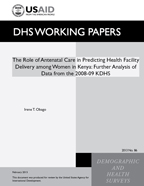- PUBLICATIONS
- JOURNAL ARTICLES
- ORDER PUBLICATIONS
Publications Summary
- Document Type
- Working Papers
- Publication Topic(s)
- Maternal Health
- Country(s)
- Kenya
- Language
- English
- Recommended Citation
- Obago, Irene T. 2013. The Role of Antenatal Care in Predicting Health Facility Delivery among Women in Kenya: Further Analysis of Data from the 2008-09 KDHS. DHS Working Papers No. 86. Calverton, Maryland, USA: ICF International.
- Download Citation
- RIS format / Text format / Endnote format
- Publication Date
- February 2013
- Publication ID
- WP86
Download
 The Role of Antenatal Care in Predicting Health Facility Delivery among Women in Kenya: Further Analysis of Data from the 2008-09 KDHS (PDF, 494K)
The Role of Antenatal Care in Predicting Health Facility Delivery among Women in Kenya: Further Analysis of Data from the 2008-09 KDHS (PDF, 494K)
